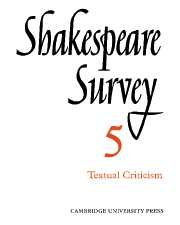Book contents
- Frontmatter
- Restoring Shakespeare: The Modern Editor’s Task
- Suggestions Towards an Edition of Shakespeare for French, German and Other Continental Readers
- The 1622 Quarto and the First Folio Texts of Othello
- An Approach to the Problem of Pericles
- The Shakespeare Collection in the Library of Trinity College, Cambridge
- New Place: The Only Representation of Shakespeare’s House From an Unpublished Manuscript
- Letters to an Actor Playing Hamlet
- Shakespeare’s Imagery: The Diabolic Images in Othello
- Suggestions for a New Approach to Shakespeare’s Imagery
- Shakespeare’s Influence on Pushkin’s Dramatic Work
- Shakespeare on the Flemish Stage of Belgium, 1876–1951
- International Notes
- Shakespeare Productions in the United Kingdom: 1950
- Shakespeare in the Waterloo Road
- The Year's Contributions to Shakespearian Study 1 Critical Studies
- 2 Shakespeares’s Life, Times and Stage
- 3 Textual Studies
- Books Received
- Index
- Plates
3 - Textual Studies
Published online by Cambridge University Press: 28 March 2007
- Frontmatter
- Restoring Shakespeare: The Modern Editor’s Task
- Suggestions Towards an Edition of Shakespeare for French, German and Other Continental Readers
- The 1622 Quarto and the First Folio Texts of Othello
- An Approach to the Problem of Pericles
- The Shakespeare Collection in the Library of Trinity College, Cambridge
- New Place: The Only Representation of Shakespeare’s House From an Unpublished Manuscript
- Letters to an Actor Playing Hamlet
- Shakespeare’s Imagery: The Diabolic Images in Othello
- Suggestions for a New Approach to Shakespeare’s Imagery
- Shakespeare’s Influence on Pushkin’s Dramatic Work
- Shakespeare on the Flemish Stage of Belgium, 1876–1951
- International Notes
- Shakespeare Productions in the United Kingdom: 1950
- Shakespeare in the Waterloo Road
- The Year's Contributions to Shakespearian Study 1 Critical Studies
- 2 Shakespeares’s Life, Times and Stage
- 3 Textual Studies
- Books Received
- Index
- Plates
Summary
Though it is customary to speak of Nicholas Rowe as the first editor of Shakespeare, the editing began at least as early as the First Folio. Evidence is not wanting that those responsible for this volume were at some pains to publish better texts than had been available previously. King Lear is a case in point, a play printed in the Folio from a copy of the ‘Pied Bull’ Quarto that had been elaborately corrected by reference to the playhouse manuscript. Somewhat the same thing was done with Troilus and Cressida, a play of which the slightly longer Folio text differs repeatedly from that of the Quarto. Final proof of this fact is presented by Philip Williams, who is thus able to dismiss once and for all the rival hypothesis that the printer of the First Folio used an independent manuscript. In the 1609 Quarto of Troilus, the printer followed certain conventions in the use of roman and italic types; so did the printer of the Folio, though the conventions were not necessarily the same. The Quarto was set by two compositors with easily recognizable habits of spelling and treatment of speech-headings; so was the Folio text of Troilus, as Edwin E. Willoughby demonstrated twenty years ago. Now Williams reports the discovery of so many cases in which the Folio agrees—abnormally — with the Quarto in the use of italic and roman types, in the abbreviation of speech-headings, and in idiosyncratic spellings, that one, and only one, explanation will suffice: a marked copy of the Quarto served as printer’s copy for the Folio.
- Type
- Chapter
- Information
- Shakespeare Survey , pp. 144 - 152Publisher: Cambridge University PressPrint publication year: 1952

